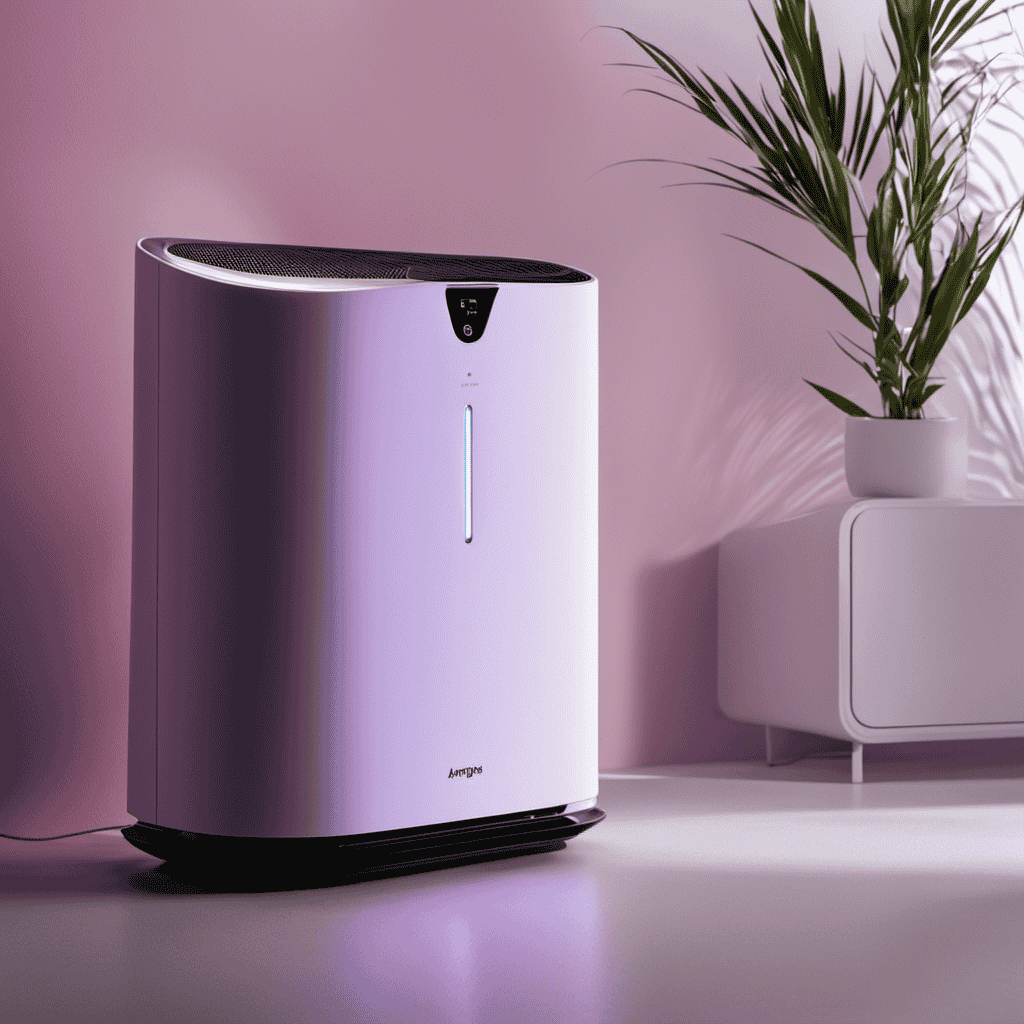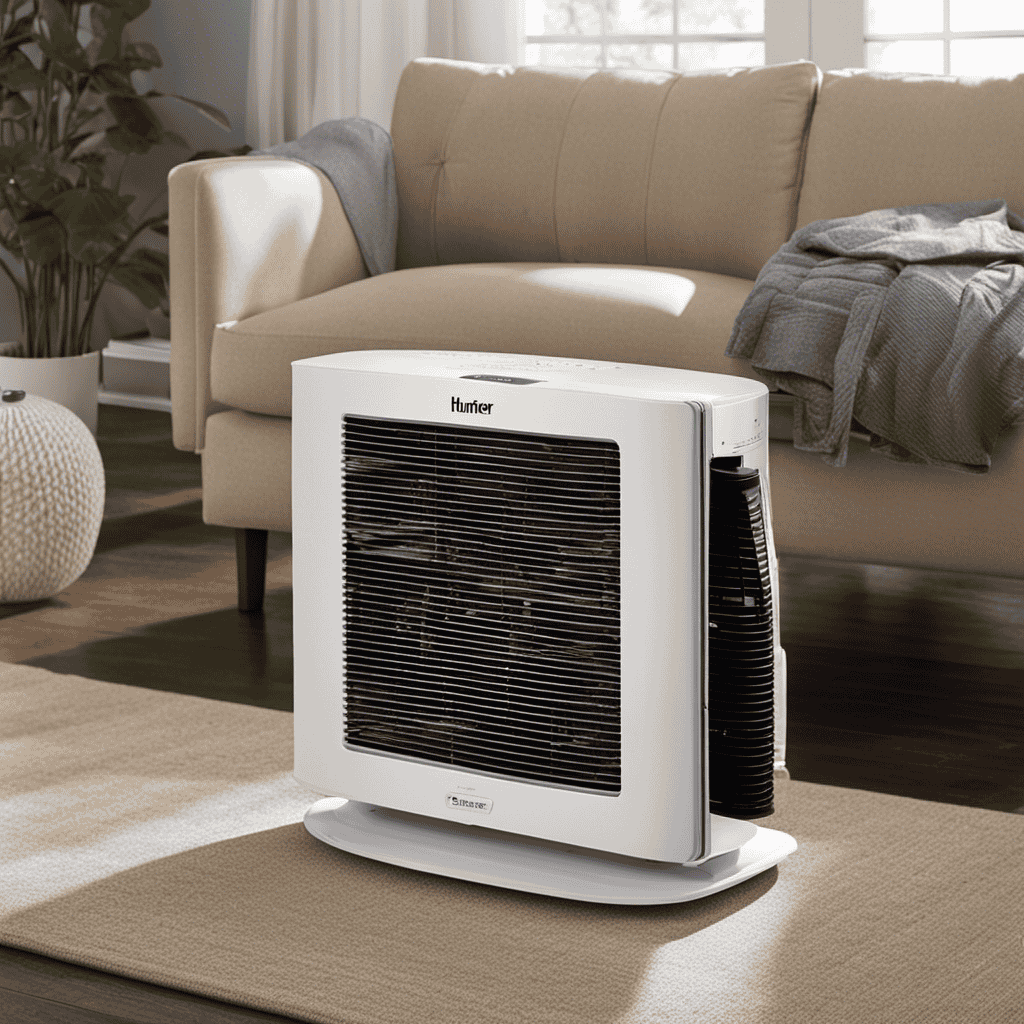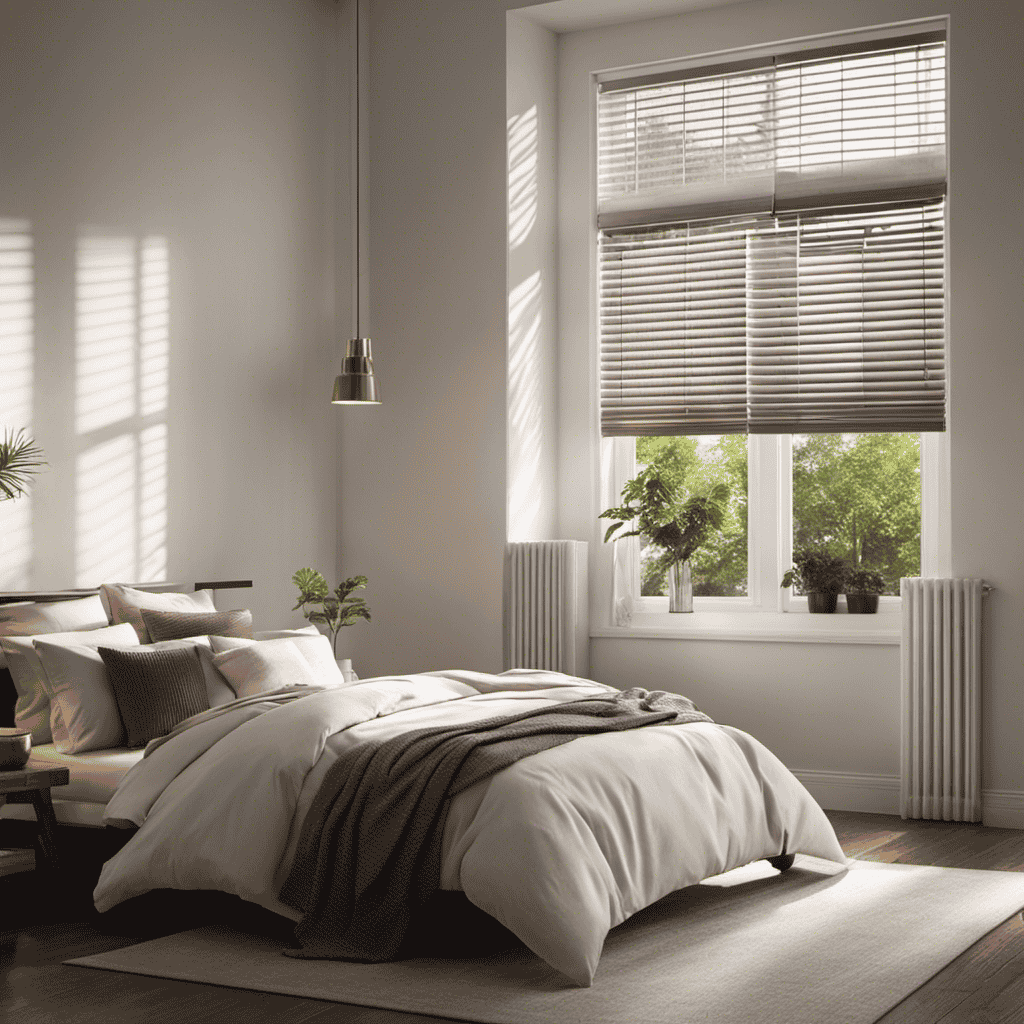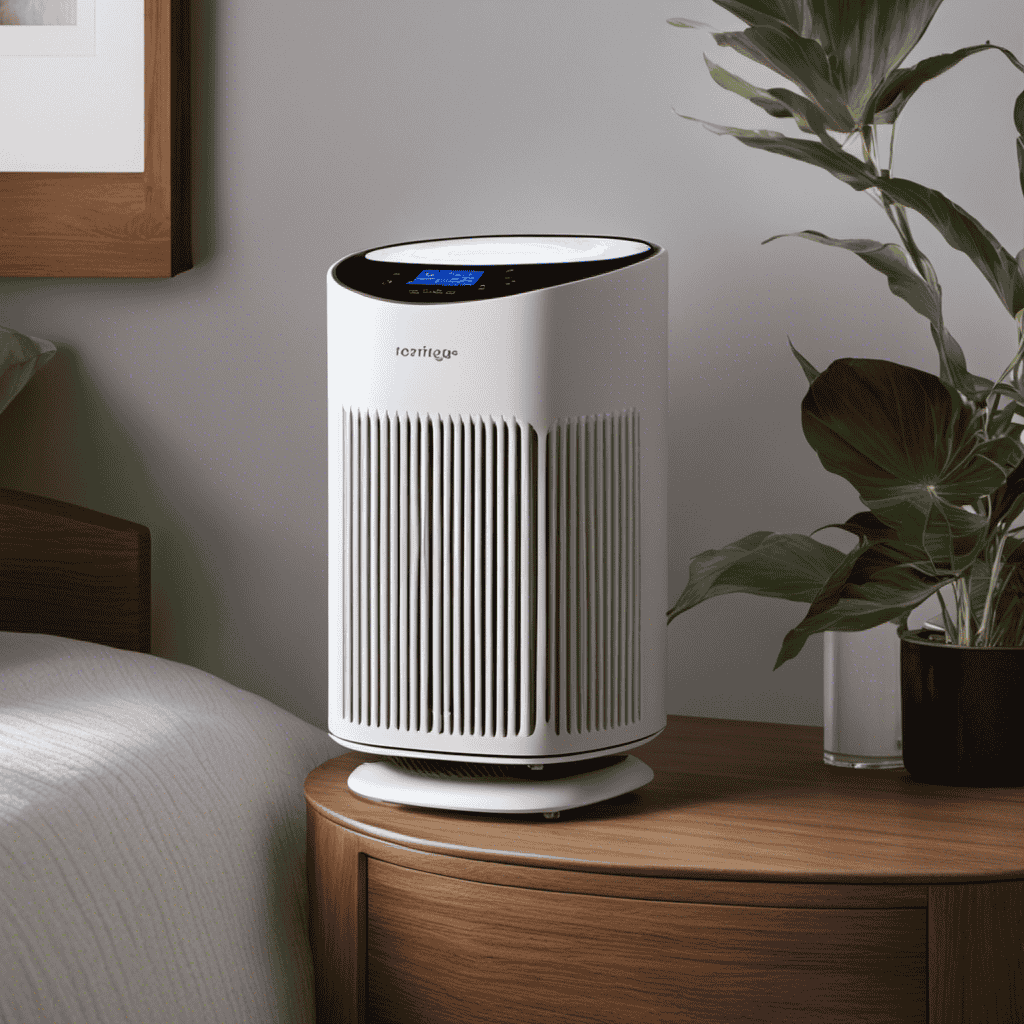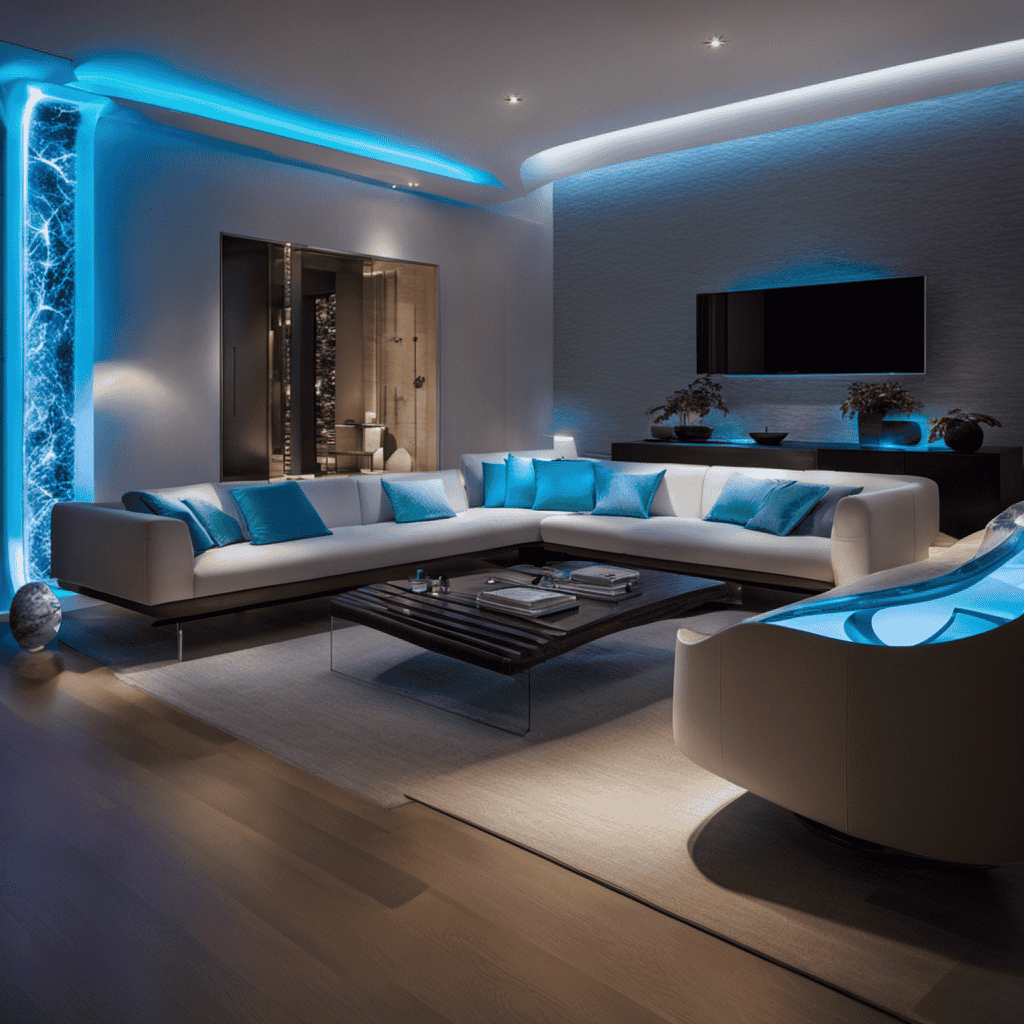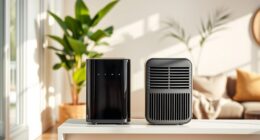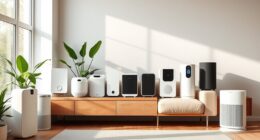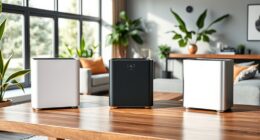Were you aware that UV light is an essential part of air purification systems? Its capacity to eliminate bacteria, viruses, and mold, positions UV light as a key player in ensuring the air we inhale is purified and conducive to good health.
In this article, I will delve into the various benefits of UV light in air purifiers, from eliminating odors to reducing allergens. Additionally, I will explore the different types of UV light technology used in these devices.
Get ready to uncover the power of UV light in air purification!
Key Takeaways
- UV light in air purifiers is used to eliminate harmful bacteria, viruses, and mold spores by damaging their DNA and preventing replication.
- UV light can have negative effects on human health, such as skin and eye damage, so it should be used with caution and following safety guidelines.
- UV light is also effective in neutralizing and eliminating unpleasant odors caused by bacteria, mold, and other contaminants in the air.
- Overall, UV light in air purifiers improves air quality by targeting and neutralizing pathogens, reducing the risk of respiratory illnesses and providing relief for allergy sufferers.
The Benefits of UV Light in Air Purifiers
UV light in air purifiers helps to eliminate bacteria, viruses, and mold spores from the air. This is because UV light, specifically UV C radiation, has the ability to disrupt the DNA and RNA of these airborne pathogens. When the DNA and RNA are damaged, the pathogens become unable to reproduce and spread.
The UV light in air purifiers works by emitting short wavelength UV C radiation that is capable of penetrating the outer structure of these pathogens. Once inside, the UV C radiation damages the genetic material, rendering the pathogens inactive and preventing them from causing harm.
This technology is highly effective in sterilizing the air and ensuring that it is free from harmful airborne contaminants. UV light in air purifiers is an essential feature for maintaining a clean and healthy indoor environment.
How UV Light Kills Bacteria and Viruses in the Air
When it comes to killing bacteria and viruses in the air, you’ll be amazed at how effective this method can be. UV light, specifically ultraviolet-C (UVC) light, has been proven to be highly effective in eliminating harmful pathogens.
UV light works by damaging the DNA and RNA of microorganisms, preventing them from replicating and causing infections. The effectiveness of UV light on different types of bacteria can vary, as certain strains are more resistant than others. However, studies have shown that UVC light is highly effective against a wide range of bacteria, including E. coli, Salmonella, and Staphylococcus aureus.
It is important to note that exposure to UVC light can have negative effects on human health, such as skin and eye damage. Therefore, it is crucial to use UV light in air purifiers with caution and follow safety guidelines.
Understanding the role of UV light in mold prevention is equally important, as it can help create a comprehensive approach to maintaining a clean and healthy indoor environment.
Understanding the Role of UV Light in Mold Prevention
Using UV light in air purifiers can help prevent the growth and spread of mold in indoor environments. UV light is effective in mold prevention due to its ability to disrupt the DNA and cellular structure of mold spores, rendering them unable to reproduce and causing them to die off.
Here are some key points to consider:
- UV light works by emitting short-wavelength ultraviolet radiation, specifically UVC light, which has germicidal properties.
- When mold spores are exposed to UVC light, the DNA and proteins within their cells absorb the radiation, leading to the formation of thymine dimers that prevent replication.
- The effectiveness of UV light in mold prevention depends on factors such as the intensity and duration of exposure, as well as the distance between the light source and the mold-infested area.
- It is important to note that while UV light can kill mold spores, it may not eliminate existing mold colonies or remove the source of moisture that promotes mold growth.
UV Light as a Powerful Odor Eliminator in Air Purifiers
When it comes to odor removal, UV light can be a highly effective tool in air purifiers. The powerful wavelengths emitted by UV light are capable of neutralizing and eliminating unpleasant odors caused by bacteria, mold, and other contaminants in the air.
Odor Removal With UV
The UV light in the air purifier helps to remove odors. Using UV light technology, the air purifier can effectively eliminate unpleasant smells by targeting and neutralizing odor-causing particles in the air.
Here are some benefits of UV light in odor removal:
-
Efficient Odor Elimination:
-
UV light breaks down volatile organic compounds (VOCs) that contribute to odors, leaving the air fresh and clean.
-
It eliminates odors caused by pets, cooking, smoke, and other sources, providing a more pleasant and inviting environment.
-
Chemical-Free Solution:
-
Unlike traditional air fresheners or deodorizers that often contain harmful chemicals, UV light offers a safe and chemical-free alternative for odor removal.
-
This makes it suitable for people with sensitivities or allergies to synthetic fragrances or harsh chemicals.
With the power of UV light technology, air purifiers can effectively tackle odors, ensuring a healthier and more comfortable living space.
Air Purification Benefits
UV light technology in air purifiers effectively eliminates odors, leaving the air fresh and clean. However, the benefits of UV light in air purification extend beyond just odor removal.
UV light is a powerful tool in the air purification process as it helps to improve overall air quality. When air passes through an air purifier with UV light, the UV rays target and neutralize harmful bacteria, viruses, and other microorganisms present in the air. This helps to reduce the risk of respiratory illnesses and infections.
Additionally, UV light also breaks down volatile organic compounds (VOCs), which are harmful chemicals that can be found in household products and contribute to poor indoor air quality.
The Importance of UV Light for Allergen Reduction in Air Purifiers
UV light plays a crucial role in air purification by effectively killing allergens and enhancing overall indoor air quality. As a powerful disinfectant, UV light has been proven to eliminate a wide range of allergens, including bacteria, viruses, and mold spores.
UV Light Kills Allergens
Using UV light in air purifiers can help eliminate allergens. It is a powerful technology that has numerous benefits in improving indoor air quality. Here are some key advantages of using UV light in air purifiers:
-
UV light technology effectively kills bacteria, viruses, and mold spores, reducing the risk of respiratory infections.
-
UV light can break down volatile organic compounds (VOCs) and other harmful chemicals, improving overall air quality.
-
This technology can also neutralize pet dander, pollen, and other allergens, providing relief for allergy sufferers.
-
UV light helps to eliminate odors by breaking down odor-causing molecules, ensuring fresh and clean-smelling air.
Enhances Air Purification
Incorporating this technology into purifiers enhances the purification process, creating cleaner and healthier indoor air. One way this is achieved is by using UV-C lamps, which emit ultraviolet light that is effective at killing airborne contaminants such as bacteria, viruses, and mold spores.
The UV-C light works by disrupting the DNA and RNA of these microorganisms, rendering them unable to replicate and causing them to die. This technology is particularly effective in eliminating harmful pathogens that can cause respiratory illnesses and allergies.
By incorporating UV-C lamps into air purifiers, the purification process becomes more thorough and efficient, ensuring that the indoor air is free from harmful contaminants.
Now, let’s explore the different types of UV light technology in air purifiers to understand how they work and their specific benefits.
Exploring the Different Types of UV Light Technology in Air Purifiers
There’s a variety of UV light technologies used in air purifiers. One of these technologies is UV-C, which is commonly used for indoor air quality improvement. UV-C light has a wavelength of around 254 nanometers, which is effective in killing bacteria, viruses, and other microorganisms in the air. The UV-C light works by damaging the DNA and RNA of these microorganisms, preventing them from reproducing and causing harm.
When it comes to air purifiers, UV-C technology can be utilized in different ways:
-
UV-C Germicidal Lamps: These lamps emit UV-C light to disinfect the air as it passes through the purifier. They are effective in eliminating airborne pathogens and reducing the risk of infection.
-
UV-C Coated Filters: Some air purifiers have filters coated with UV-C material. This technology enhances the filtration process by killing microorganisms that may be trapped in the filter, preventing them from being released back into the air.
Frequently Asked Questions
Can UV Light in Air Purifiers Harm Humans or Pets?
UV light in air purifiers can harm humans and pets if they are exposed to it directly. However, when used properly, UV light is effective in killing germs and preventing the spread of airborne diseases.
How Long Does It Take for UV Light to Kill Bacteria and Viruses in the Air?
UV light is highly effective in killing airborne pathogens. The intensity of UV light directly impacts its ability to eliminate bacteria and viruses. Understanding the duration it takes for UV light to neutralize pathogens is crucial for air purification.
Are All Air Purifiers Equipped With UV Light Technology?
Not all air purifiers are equipped with UV light technology. However, those that are offer several benefits. UV light is effective in killing airborne pathogens such as bacteria and viruses, making the air cleaner and safer to breathe.
Can UV Light Eliminate All Types of Odors in the Air?
UV light is effective in eliminating various types of odors in the air. It has the power to neutralize odor-causing molecules and bacteria, ensuring a fresher and cleaner environment.
Does UV Light Technology in Air Purifiers Require Maintenance or Replacement?
UV light technology in air purifiers requires regular maintenance and occasional replacement. The UV light helps eliminate bacteria and viruses in the air, but over time, the intensity of the light decreases, reducing its effectiveness.
Conclusion
To conclude, the utilization of UV light in air purifiers is a game-changer. Its ability to eradicate bacteria, viruses, mold, and odors is remarkable.
Additionally, UV light plays a crucial role in reducing allergens, making it an essential component of any air purifier.
With various types of UV light technology available, consumers have a wide range of options to choose from.
In summary, the inclusion of UV light in air purifiers is a powerful tool that enhances indoor air quality and promotes a healthier living environment.
